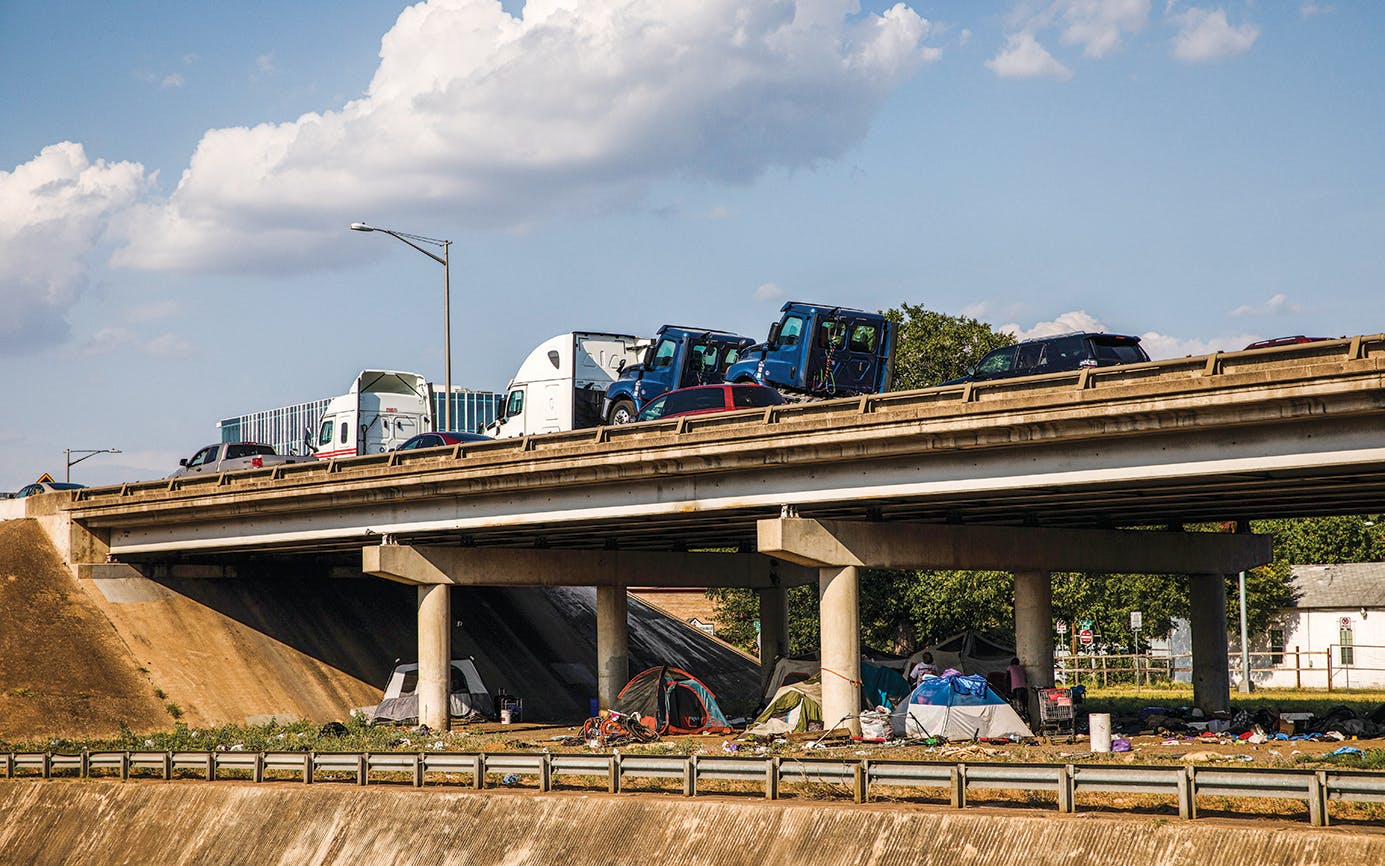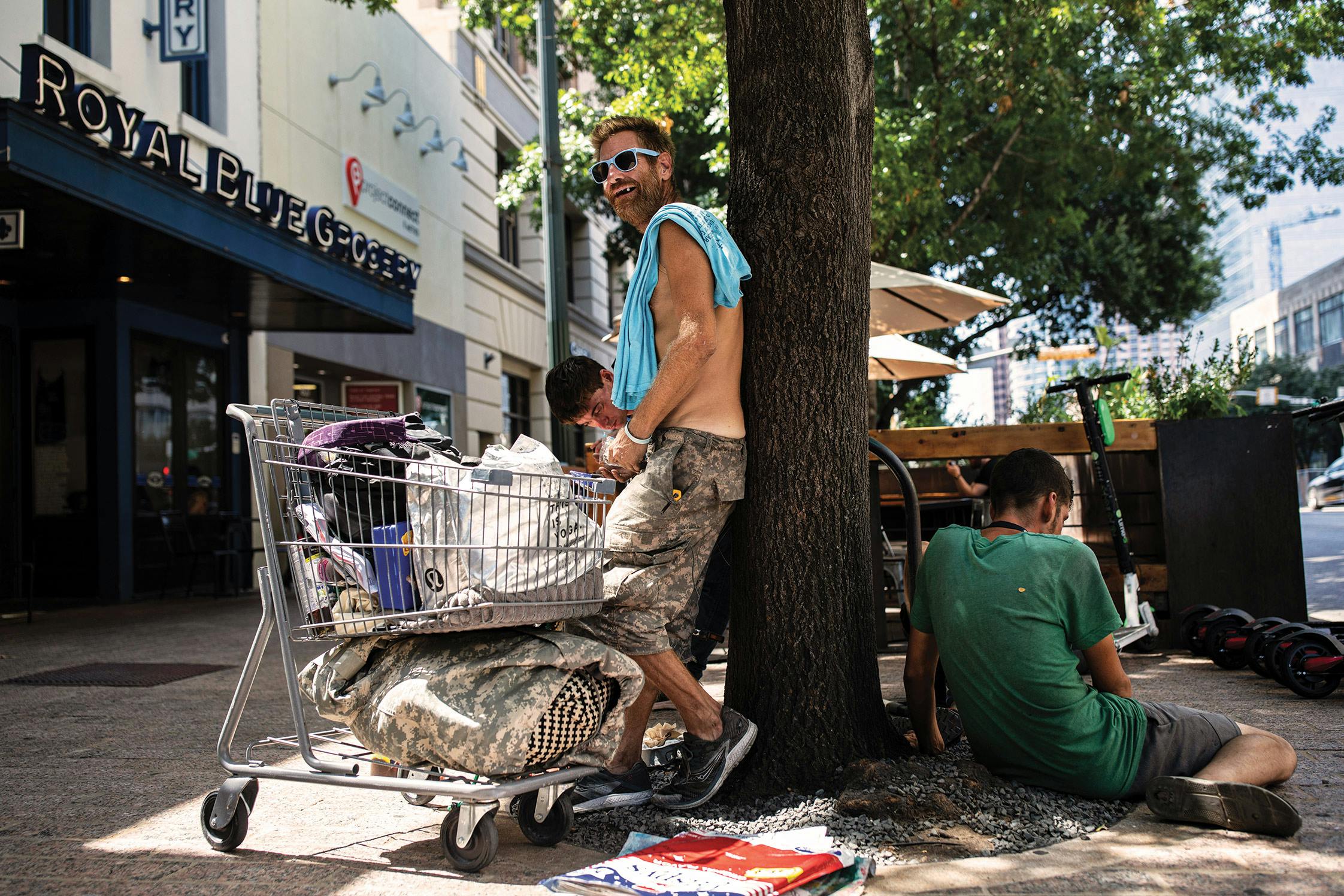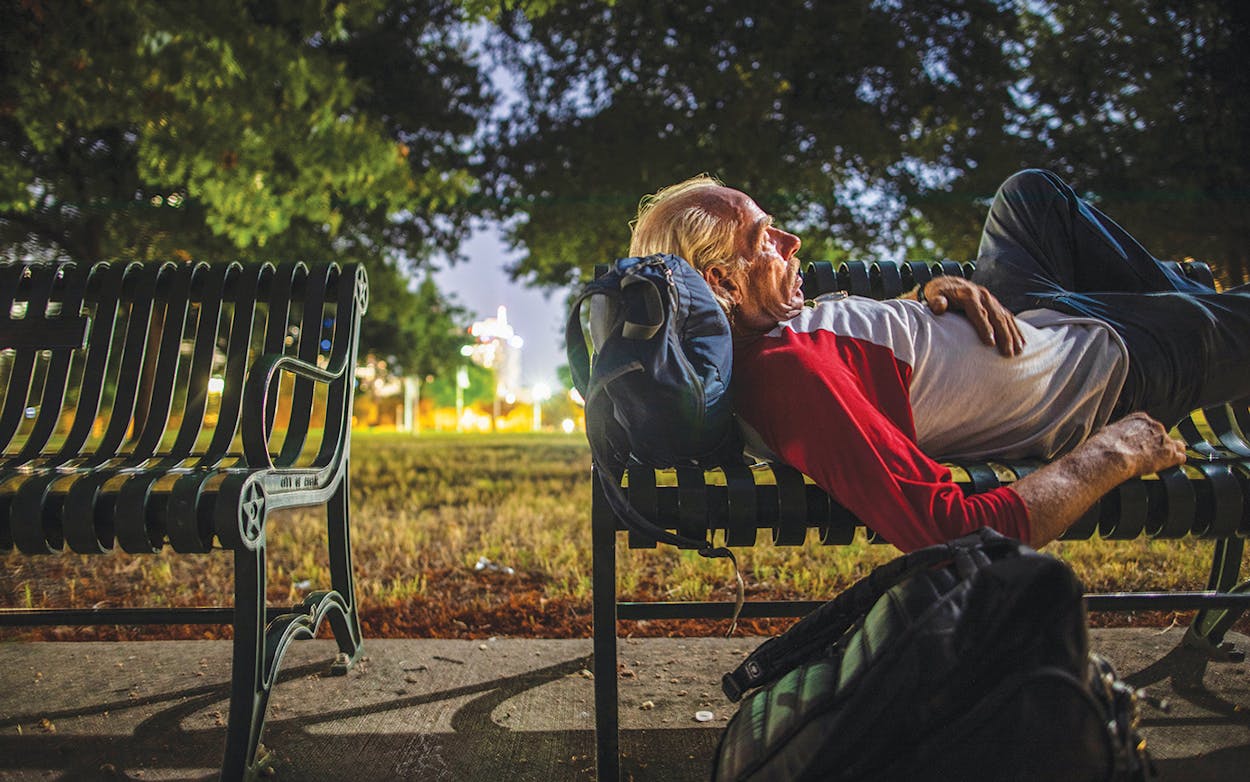Austin’s summer of discontent began with a sixteen-hour city council meeting. Council hearings are often marathon affairs, running into the wee hours, after sense and patience have gone to bed. The June 20 meeting was certainly a slog. By 2:20 a.m., the council had voted to effectively legalize sleeping, camping, and panhandling on sidewalks and in other public spaces. In doing so, city leaders upended an unspoken arrangement with the public that had persisted for more than two decades, one that criminalized homelessness and made the homeless less visible.
Here’s how the bargain had worked: Without enough shelter space to get people off the streets, Austin had tasked the police with enforcing ordinances that made it illegal to aggressively panhandle, sit or lie on sidewalks, and camp in public. In a never-ending game, the police would move the homeless around, sometimes pushing them into out-of-the-way, dangerous places like the banks of creeks. Those who refused to move along were given citations, which often then led to arrest and jail.
The Austin City Council, which has been moving to the left in recent years, deemed this an unacceptable situation. So at the June meeting, the council voted overwhelmingly to weaken the ordinances. Panhandling was now legal as long as supplicants did not engage in “aggressive confrontation.” So was sitting and lying on sidewalks, as long as the person in question didn’t block rights-of-way. Camping was no longer illegal in public spaces, including sidewalks and under bridges, though it was still expressly prohibited in places like public parks.
Proponents sold the move as smart, compassionate policy that would decriminalize homelessness and bring homeless folks out of the shadows, part of a broader push to add hundreds of new shelter beds, expand affordable housing, and increase funding for homeless outreach. Progressive, forward-thinking Austin would lead the way. “You and I spend millions of taxpayer dollars playing this perverse game of moving people around and solving nothing,” wrote Mayor Steve Adler in an op-ed in the Austin American-Statesman. “I refuse to play any longer.” For the first time in a long while, Austin’s homeless were able to get a good night’s sleep. Then all hell broke loose.

The decriminalization measures caught many Austinites by surprise, even though they had been in the works for years. Into the vacuum rushed a tidal wave of misinformation. Some citizens came to believe that the city had legalized trespassing on private property (it hadn’t) or that elected officials were now allowing the homeless to build tent cities in public parks (they weren’t). Email chains and Nextdoor posts in well-heeled parts of Austin spread alarming stories about unsightly behavior by the homeless and condemned “Spendthrift Steve and the Commie Council,” as one West Austinite dubbed the city’s leaders. Local TV news had a field day connecting isolated incidents of bad behavior to the revised ordinances.
When a local conservative activist posted pictures of a car crash he said had been caused by homeless people running into traffic, Governor Greg Abbott jumped on the bandwagon. “Look at this insanity caused by Austin’s reckless homeless policy,” he tweeted. “The horror stories are piling up.” (The Austin Police Department soon reported that there was no evidence that pedestrians were involved and said a driver had apparently run a red light.) The board chair of the Austin Chamber of Commerce incorrectly claimed in an op-ed he coauthored that the city was proposing to make it legal for the homeless to harass people on the street. The chairman of the Travis County Republican Party, Matt Mackowiak, tweeted that the changes “must be rescinded before someone gets killed.” The general counsel of the conservative Texas Public Policy Foundation tried to popularize the term “Adlervilles” for homeless encampments, echoing the “Hoovervilles” of the Great Depression.
The increased visibility of the homeless led many Austinites to think that their numbers had skyrocketed, though the size of the city’s homeless population has remained relatively flat for years, at about two thousand. Their mere existence became a point of political contention. Mackowiak laid out his plan on Twitter, which boiled down to “get them off the streets and get them treatment.” But in the next tweet, he slammed the city for spending money on a planned shelter in South Austin that some neighboring homeowners opposed.
As the summer wore on, the rhetoric got more heated. Lost, at times, amid the sound and fury were the actual questions at stake. Did the new rules help the homeless? Were the benefits worth the costs? And what can be done to reduce homelessness in Austin and other Texas cities?

Austin’s anti-camping ordinance dates back to 1996, when a previous city council felt pressure to do something about the local homeless population. The city’s businesses had been asking for more help for years, and isolated reports of crimes had caught the public’s attention. “This ordinance sends out a clear message to people who choose to sleep in our right-of-ways and public sidewalks that we will not stand for it,” Jose Martinez, then the executive director of the Downtown Austin Alliance, told the Austin Chronicle at the time. Others charged that the camping ban was counterproductive and unconstitutional: when the ordinance went into effect, famed columnist Molly Ivins protested by spending the night in a sleeping bag on Congress Avenue, alongside outlaw country musician Steven Fromholz.
Perhaps surprisingly, APD was one of the loudest voices against the 1996 law. “Maybe the council should have thought this through a little more,” Lieutenant Michael Urubek told the Chronicle. “[The council members] said, ‘We’ll talk our game; we’ve done our job [by passing the ordinance]. And now we are not going to have homelessness anymore.’ ” But policing the homeless wasn’t APD’s job, Urubek said. The department had no intention of using the ordinance to ticket people except in “special situations”—in part because “if they end up in jail, they’ll just bounce back out.”
Eventually, APD overcame those concerns. From 2014 to 2016, Austin cops wrote about 18,000 tickets for violations of the three ordinances. In a series of well-researched reports, city auditors argued that ticketing was an impediment to getting people off the streets. The tickets usually turned into arrest warrants, which made it even more difficult for people experiencing homelessness to get jobs and find housing, and the judicial system had proved ineffective in connecting the homeless to services such as drug treatment and counseling.
Both proponents and critics of the city council’s action in June agree on one thing: decriminalizing homelessness has had real consequences for life in downtown Austin. Unafraid of being hassled, the homeless have settled in. “We quickly saw a difference,” said Greg McCormack, the executive director of Front Steps, a nonprofit that runs the Austin Resource Center for the Homeless, or ARCH, Austin’s downtown shelter for men. “We’ve already seen many more people sleeping on the sidewalk, people putting up a little shelter.” Austinites worry that downtown will become like the hellish Skid Row in Los Angeles or parts of Seattle and San Francisco.
Business owners and residents in Austin’s increasingly upscale downtown have not been quiet about their fears. Craig Staley, who co-owns Royal Blue Grocery, a chain of stylish bodega-type stores, said that the change has produced an elevated sense of “empowerment” in homeless people, who he says are increasingly confronting his employees and brazenly shoplifting. “When we first opened our store last decade, if you had trouble with someone that was homeless, you’d say, ‘You can’t sit there,’ and they’d say, ‘Okay, sorry.’ And now it’s ‘Screw you.’ They changed the world downtown in about three weeks.”
He’s fearful for the safety of his employees and worries the smells and the sights will turn tourists away from Austin. “We had a homeless problem, and city leaders turned it into a crisis,” he said. He points to a breathless hour-long documentary available on YouTube called Seattle Is Dying, in which Seattle police complain that elected leaders have made them “impotent” to control the city’s homeless population.

Capitol Costs
The 250 most “expensive” homeless people in Travis County each cost local government about $223,000 a year in medical, jail, shelter, and other costs.
In August, I spoke to one of Staley’s customers just down the street from Royal Blue. Catherine Fako was sitting in the shade with her dog, Princess. Fako, 33, is a big fan of the store’s banana bread pudding. She’s been homeless off and on since she was 16 and has lived in Austin since 2012. The change in the ordinances, she said, has produced an almost revolutionary improvement in her quality of life. “I can sleep without getting woken up by the police every five minutes. I actually get a good night’s sleep now,” she said. “I don’t get assaulted as much when I sleep anymore, because I don’t have to hide to sleep . . . somewhere in a dark alley.”
Fako estimates that she has received some fifty citations from police just from the sit/lie and camping ordinances, and she’s lost track of how many times she was arrested for them. Each time, she said, “they’d take my dog to the pound, take me to the jail, book me in, and say, ‘This is not a jailable offense,’ and then write me a court date.” But Fako also thinks there are problems with the current rules. “I see the way people set up tents places where they probably shouldn’t, like right outside of some of these housing buildings,” she said. “Some people are taking advantage of it.”
Fako is hopeful she’ll be able to find a place to live by the end of the year—she’s on a wait list for a nonprofit housing development—and in the meantime, the new stability she’s experiencing has made life easier for her in between odd jobs, like cleaning up at downtown bars.
For Fako, at least, decriminalization is working as it should. “When I was in Seattle and L.A.,” Mayor Adler told Texas Monthly, “both of their mayors told me that they wished they had stopped moving people around sooner and actually built the housing that would allow them to deal with it.” The endless reshuffling of people living at the margins of society constituted an enormous drain on city resources while also making homelessness worse.
Decriminalization, Adler says, is a small part of the city’s overarching plan to tackle homelessness. “There’s a lot of angst in the community, because most people are wondering if we have a plan,” he said. “It’s important for people to know that we don’t want anyone camping anywhere in this city.” Austin is one of several Texas cities, Abilene and San Angelo among them, that have virtually eliminated homelessness among veterans, and the Capital City has seen a 56 percent drop in unsheltered homeless children since 2018.
The council is making substantial investments in long-term infrastructure. ARCH has a mere 130 beds. With the new shelter planned for South Austin, the city is adding another 100, and nonprofits, with city funding, are building additional supportive housing developments like the one in which Fako hopes to live. The city is also investing in a shelter for homeless families in East Austin, run by the Salvation Army, which will hopefully take parents and children away from the sometimes squalid and rowdy camps downtown.

Many people think that homelessness is intractable and unsolvable. In August, U.S. senator John Cornyn, a Texas Republican, tweeted that gun violence and homelessness are both potentially immutable problems “where we simply don’t have all the answers.” Eric Samuels, the president and CEO of Texas Homeless Network, disagrees. “Well, we do, actually,” he said. “And we would love to talk about it.” Perhaps naively, supporters of decriminalizing homelessness hope that the backlash against it has set off a productive conversation about a social ill that they believe is fixable if enough attention is paid.
One of the more surprising facts about the homeless population in Texas is its relatively small size. Accurate counts of the homeless are hard to come by, but according to the most widely accepted survey, on any given night there are about 25,000 homeless people in this state of almost 29 million. There may be as few as 3,300 who are chronically homeless. If Texas were a country, it would have the tenth-largest economy in the world: the housing and care of 3,300 people, whatever their special needs, would seem to be within our grasp.
The popular perception is that most people who become homeless are mentally ill or have substance abuse issues, but in reality most do so because of an economic shock such as unemployment or medical bankruptcy, and many fix the problem themselves. “Eighty percent of those who become homeless self-resolve in thirty days or less,” said McCormack. Some find a place to stay after a night or two.
In the past four years, Austin’s homeless population has ranged between 2,000 and 2,300—or about 2 percent of the crowd at a home football game of the Texas Longhorns. That number has been ticking up in recent years, but it’s still lower than in 2011, when Austin and the rest of the country were coming out of the Great Recession.
What’s more, studies have repeatedly found that homelessness has a strong correlation with housing costs. The nation’s most expensive cities—San Francisco, New York, Los Angeles, Seattle—also have some of the largest homeless populations on a per capita basis. Soaring rents and housing prices, like the ones Austin has seen in recent years, almost inevitably produce an uptick in the homeless population.
Advocates believe they have a pretty good road map for solving homelessness. First and foremost, provide stable housing. In the past decade, the Housing First model has been widely embraced. The idea is that instead of shuttling people through shelters, they ought to be put into permanent housing as quickly as possible, hopefully in a supportive environment. It’s also helpful to break the homeless population into constituent parts—veterans, families, economic hardship cases, those who need medical and psychiatric help—and then tailor different approaches to reach each group.
Houston, which has seen explosive population growth and rising housing costs, has made an aggressive effort to expand access to affordable housing and services. Experts credit the decrease in its homeless population—from about 8,500 in 2011 to about 4,000 today—to a concerted effort by city government, nonprofits, and faith leaders as well as a big infusion of funding from the U.S. Department of Housing and Urban Development. It also helps that Houston’s housing prices aren’t as high as those in Austin and Dallas.
Austin has its own success stories. For example, Community First Village is a remarkable and widely lauded project run by a former real estate developer that offers long-term housing to some of the neediest among the homeless. At Community First’s welcoming campus, 180 formerly homeless people live in RVs and tiny homes directly connected to services and work opportunities such as an on-site mechanic’s shop. They live alongside 75 volunteers, called missional residents, who help support their neighbors.
The city is also putting more money into affordable housing, hoping to attract additional federal help, just as Houston did. But the revenue caps imposed on local governments by the Legislature in 2019 will make it harder for Austin to fund homeless services. The initiatives already underway to provide housing will take time to bear fruit, and they don’t address the mounting political backlash to once again make the homeless less visible.
By late summer, the city council was united on one thing: their decriminalization work needed improvement. But council members were so divided that in mid-September a planned vote on two competing proposals was scrapped, with the council planning to meet again in October.
Then, in early October, Governor Abbott reentered the debate by pledging to use state agencies to supersede Austin’s own rules if the city didn’t crack down on homelessness to his satisfaction by November 1. He even warned that he could deploy state police to enforce trespassing laws. It remains to be seen whether the pressure campaign will push Austin back to the days when the police heavily managed the homeless or to a compromise that addresses the needs of downtown residents, including people experiencing homelessness.
Adler has taken the criticism in stride, charitably interpreting the governor’s threat as an offer of aid. “This is a community right now that is locked on the goal of ending homelessness,” Adler said. “It would be easier, it would happen more rapidly, if we had the state’s support.”
This article appears in the November issue of Texas Monthly with the headline “Street Fight.” Subscribe today.
The original online version of this article contained an incorrect figure for the costs associated with the 250 most “expensive” homeless people in Travis County. The correct amount is $223,000. The article has been updated.
- More About:
- Homelessness
- Austin









